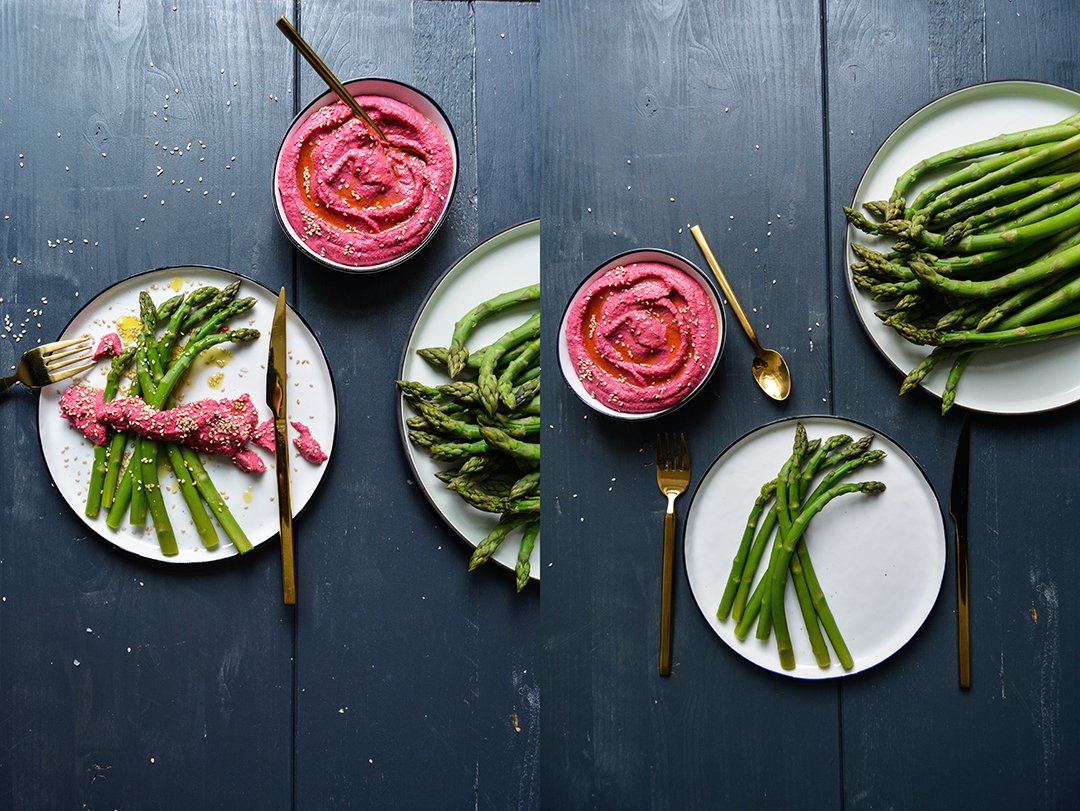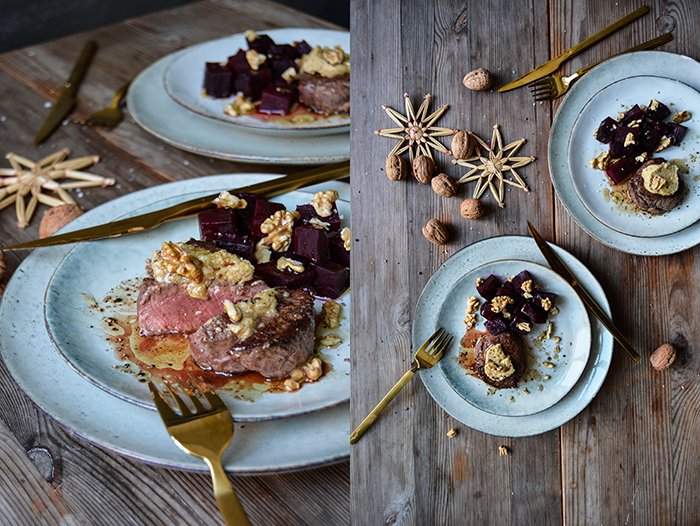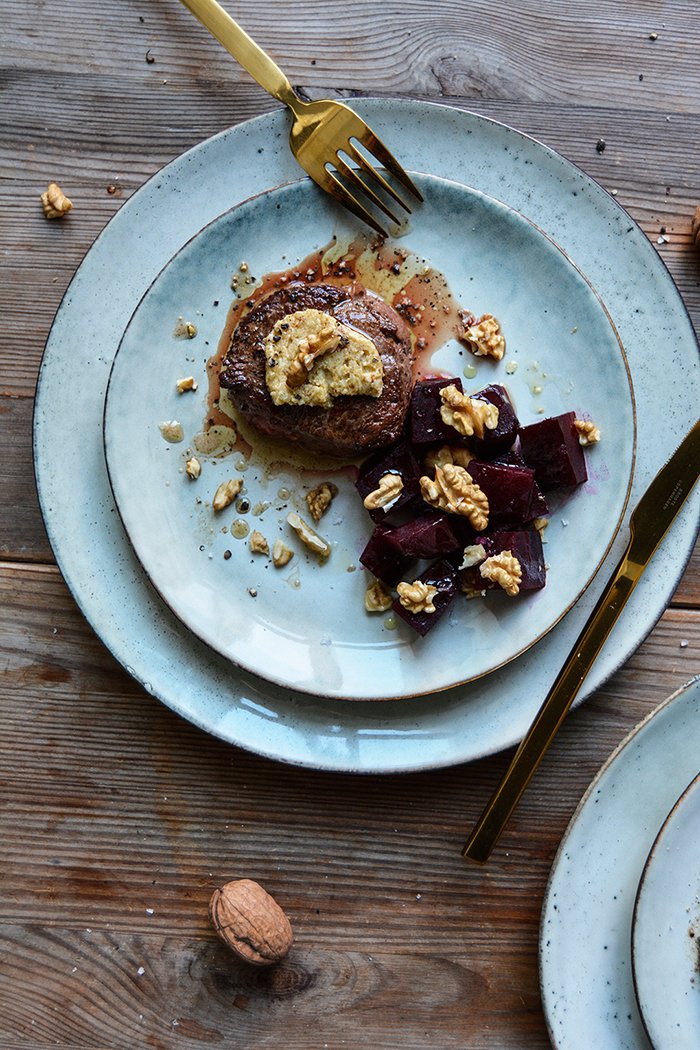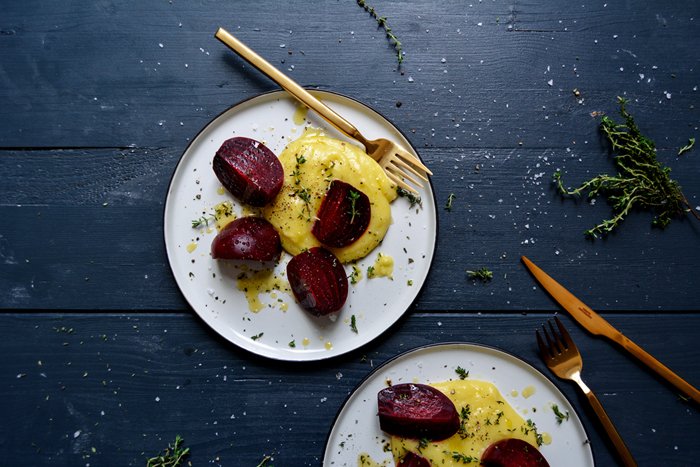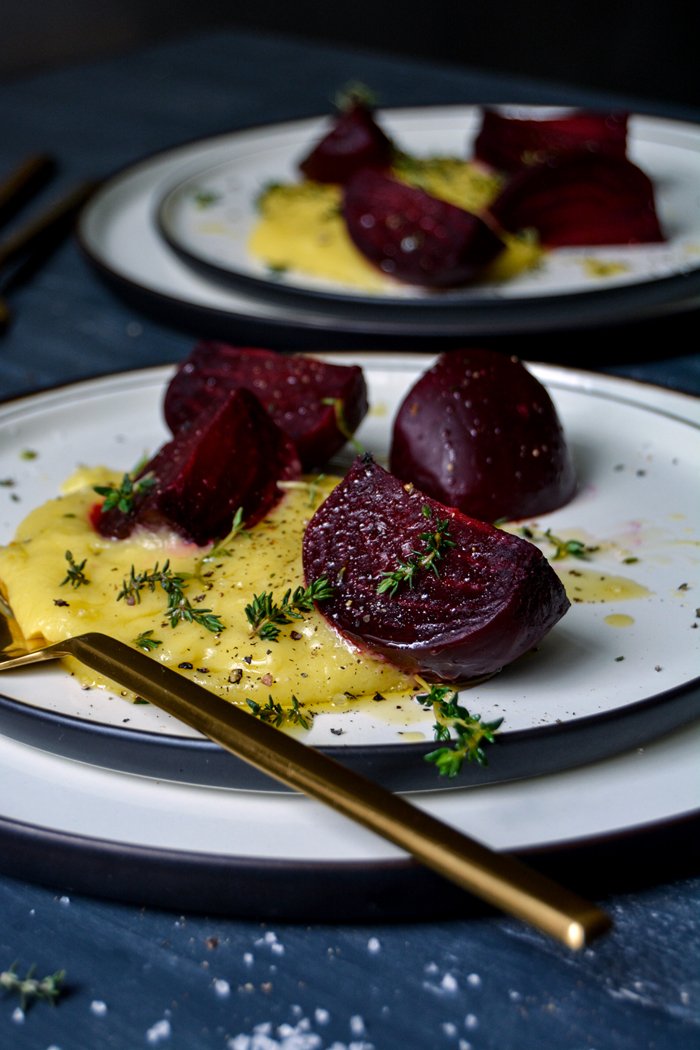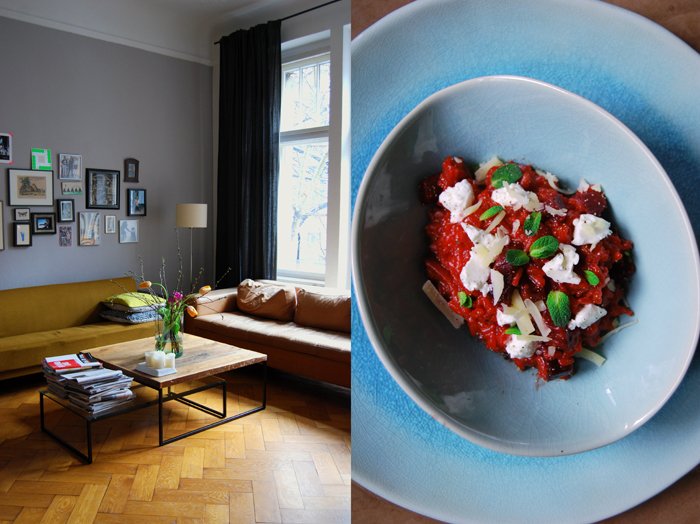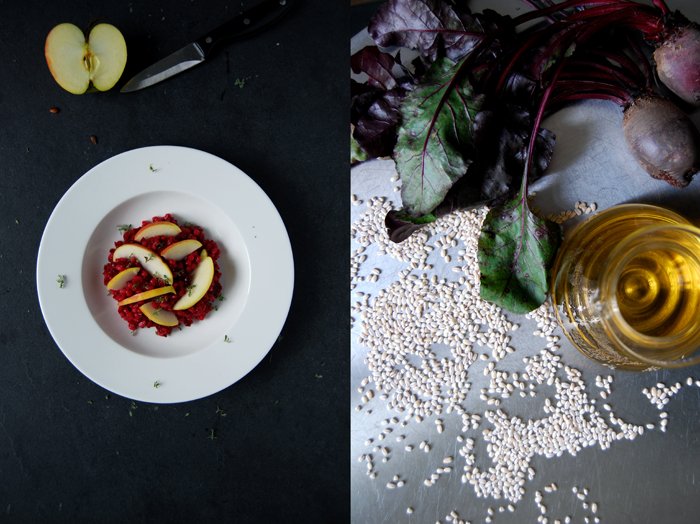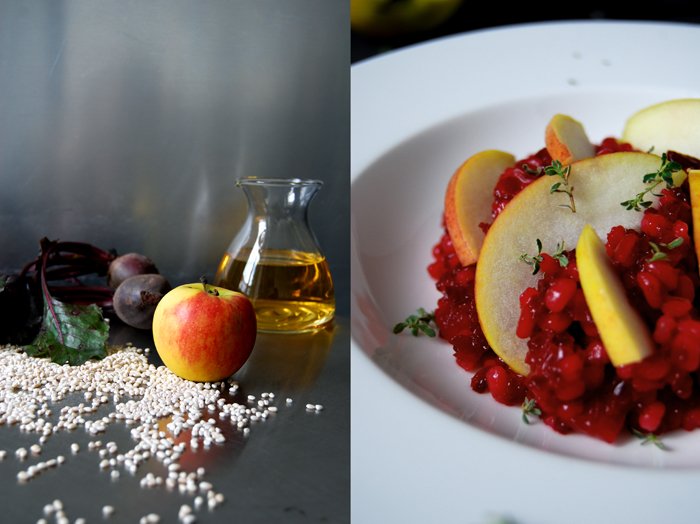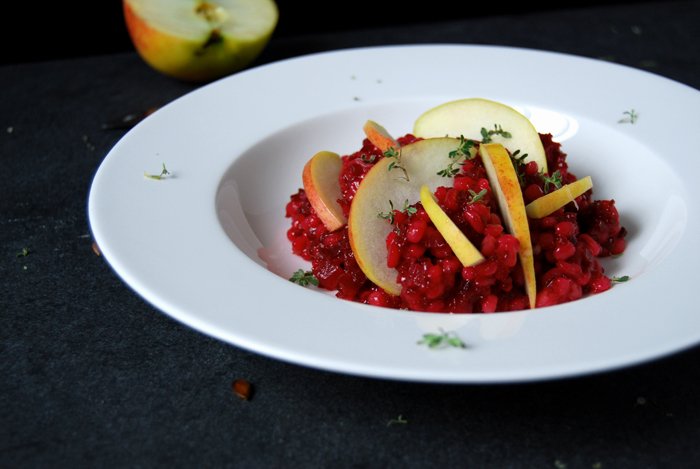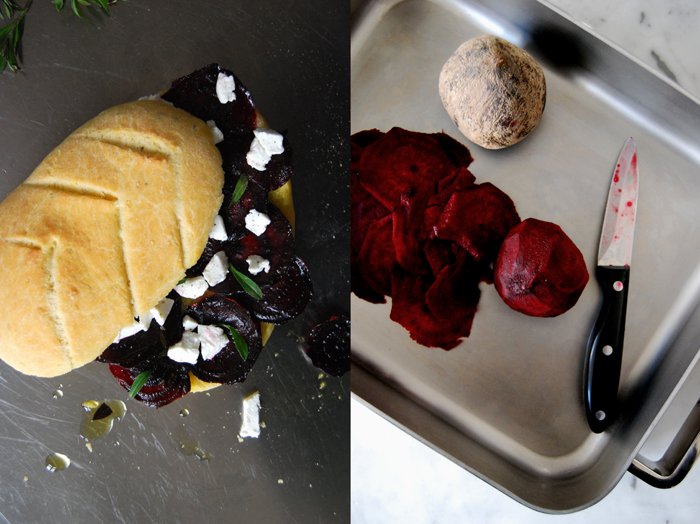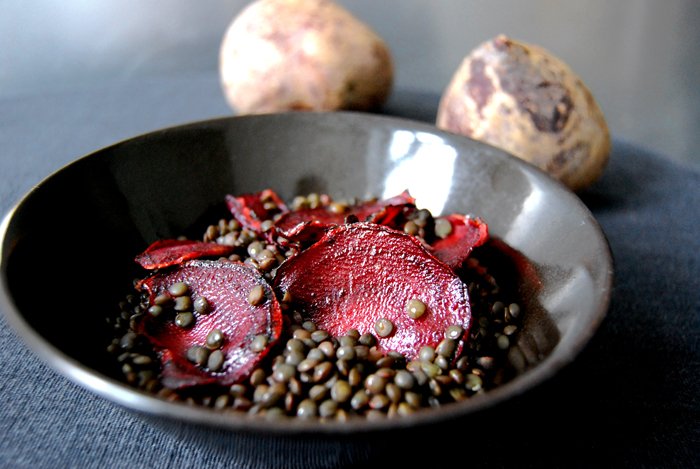Green Asparagus with Beet and Chickpea Hummus
Pink and spring green! Today's dish celebrates this vibrant colour combination and I can't really say that I expected the result to taste that good. My green asparagus stalks found a perfect companion in a screaming pink hummus. I adjusted its colour and taste by adding a generous amount of boiled beetroots. At first I was worried that the roots' earthy tones would dominate, so I started with one root for a small can of chickpeas. But there was no need to worry. The beetroot easily found its place in the nutty dip, in fact, it's a fine sweetness that comes through the most.
Before the roots kicked in, I used my basic hummus recipe to start with. It perfectly balances out the flavours of chickpeas, rich tahini, sour lemon, and the punch of fresh garlic and ground cumin. It was a recently published cookbook that inspired my to turn my hummus pink. Joel MacCharles and Dana Harrison's book called Batch, a comprehensive collection of pantry recipes, caught my attention and made me wish I had a whole room and not just a shelf to store my jars of preserved goods. Their book covers various methods for canning, dehydrating, fermenting, cellaring, salting, smoking, and infusing. As I thumbed through the pages, I noticed that there are still a lot of preserving techniques I have to learn more about. I cook my own jams and chutneys, preserve my gherkins, lemons and other fruits and vegetables, I learned to make gravad lax from my mother (a recipe that comes to use at least once a year), but I've never made my own sauerkraut or smoked mussels.
Batch is a book that needs time and attention, a book that gives you lots of basic recipes to follow and not to experiment with. It's about learning the right techniques to be able to fill the shelves in your pantry with pride and satisfaction. However, the duo also included quite a few creations that allow you to play with your preserving results and be creative. In the beet chapter, Joel and Dana write about a pink beet hummus, which is different to mine: they don't add chickpeas, it's the pure red root that shines. Below you can find both recipes, my chickpea and beet hummus and Joel and Dana's pure beet hummus. Try both and enjoy. I just love my chickpeas. But don't forget to add green asparagus cooked al dente, it's too good. And use the leftover dip to spread on dark spelt bread.
Green Asparagus with Beet and Chickpea Hummus
Serves 3-4
For the beet and chickpea hummus
medium to large beetroots, unpeeled, 2
bay leaves 2
olive oil 2 teaspoons
drained and rinsed canned chickpeas, 240g / 1 1/3 cups
tahini 150g / 5 ounces
water 120ml / 1/2 cup
freshly squeezed lemon juice 6 tablespoons
garlic, crushed, 2 large cloves
ground cumin 1/4 - 1/2 teaspoon
fine sea salt about 1 1/4 teaspoons
For the asparagus
green asparagus, rimmed, 1kg / 2 1/4 pounds
olive oil
flaky sea salt
white sesame seeds
Bring a medium pot of salted water to the boil. Add the beetroots (with their skin) and bay leaves, cover with a lid, and cook the roots over medium heat (simmering) for about 45-55 minutes or until tender. Rinse with cold water and let cool for a few minutes. Peel the roots and weigh 200g / 7 ounces, use any remaining beetroot for another recipe. Using a food processor or blender, purée the beetroots and 2 teaspoons of olive oil until smooth. Transfer to a bowl and set aside.
For the hummus, using the same food processor or blender, purée the chickpeas, tahini, water, lemon juice, garlic, cumin, and salt until smooth. Add half the puréed beetroot to the hummus and purée until well combined. Add more puréed beet until the hummus has the desired taste. I added the whole 200g / 7 ounces of beet. Add more lemon juice, salt, and cumin to taste.
Cook the asparagus in plenty of salted water for about 3 minutes or until al dente, rinse briefly with cold water, drain, and transfer to a large plate or divide between the plates. Serve warm or cold, drizzle the asparagus with a little olive oil, and sprinkle with sesame and salt. Dollop a few teaspoons of the hummus over the green stalks and enjoy!
Alternative beet hummus recipe:
Joel MacCharles and Dana Harrison's Beet Hummus
from Batch, published by appetite by Random House
Serves 2-3
garlic, peeled, 3 cloves
tahini 120ml / 1/2 cup
ground cumin 2 teaspoons
sesame oil 2 teaspoons
fresh lemon juice 2 tablespoons (add more if you wish)
canned beetroots 1l / 1 quart-jar (you can find a recipe for pressure canned beets in the book, but you can also use my recipe above to boil the beets)
beet stock (preserving / boiling liquid) 60ml / 1/4 cup
olive oil (optional)
Place the garlic in a blender and chop until fine.
Add the tahini, cumin, sesame oil, and lemon juice to the blender. Scrape the sides to make sure the garlic is incorporated and blend for 10 seconds.
Add the beets and blend until smooth. Add the beet stock, 1 tablespoon at a time, until the hummus achieves the texture you like (you may not use the whole 60ml / 1/4 cup or you may have to add more). Chill in the fridge for a few minutes before eating (optional). Serve in a bowl and a drizzle of olive oil.
Winter Caprese: Blood Orange, Beetroot, and Mozzarella di Bufala
I'm sure that I can smell it, I can hear it, if not even feel it on my skin. The promise of spring is in the air. The birds sitting on the naked branches of the tree in front of our living room window know more than us and they sing it out loud. Their voices vibrant and full of energy, they herald winter's nearing end.
With me, it's the same every year, I get impatient, frustrated. I can't wait to pull shorts and dresses out of my wardrobe, and sit outside in one of the city's cafés on a lazy Saturday afternoon, decadently sipping on a glass of chilled white wine. I want to see ripe tomatoes, lush basil, and plump peas on my kitchen table. I already dreamed of a colourful caprese salad waiting for me on a plate - and then I started to think "Wait, it's February, hold on!". But how about a little creativity and open mindedness, what about a winter caprese? There's mozzarella di Bufala in my fridge, sweet blood oranges replace the tomatoes, and boiled beetroot adds an earthy tone that goes unbelievably well with both the fruit and the cheese. I sprinkled it with a sweet date syrup vinaigrette, but maple syrup would be just as good, and a handful of fresh basil leaves (a hint of summer). It was one of the best lunches I've had in a while.
Tomorrow's the start of the crazy season again, carnival's back! If you're looking for some traditional sweet treats for yourself and your loved ones, try one of these sticky fried gems:
Winter Caprese: Blood Orange, Beetroot, and Mozzarella di Bufala
Mind that the beetroot has to cook for about 45 minutes.
Serves 2 for lunch or 4 as a starter
For the caprese
medium beetroot 1
bay leaf 1
small blood oranges, peeled and sliced, 4
mozzarella di Bufala, drained and torn into 2 or 4 pieces, 125g / 4 1/2 ounces
fresh basil leaves, a small handful
black peppercorns, crushed in a mortar (optional)
For the vinaigrette
olive oil 3 tablespoons
balsamic vinegar 1 tablespoon
white balsamic vinegar 1 tablespoon
date syrup (or maple syrup) 1/2-1 teaspoon
fine sea salt
ground pepper
Bring a medium pot of salted water to the boil, add the beetroot and bay leaf and cook for about 45 minutes or until the beetroot is tender (prick with a skewer to check). Rinse with cold water and let it cool; then peel and slice the beetroot.
For the vinaigrette, in a small bowl, whisk the olive oil, both vinegars, and the date syrup. Season with salt pepper and additional date syrup to taste.
Arrange the beetroot and blood orange in a circle on the plates, place the mozzarella in the middle. Drizzle with the vinaigrette (you might not need all the dressing) and sprinkle with basil and crushed pepper. Serve immediately.
Fillet of Beef, Walnut Butter and Beetroot and scrumptious menus for Christmas
There are many ways to celebrate the holidays and a lavish feast is my way of creating a festive culinary frame when the Christmas bells start ringing. To fill the bowls and platters with roast and gravy, stuffed duck or goose, dumplings and various cabbage dishes may take some time, but these hours spent in the kitchen are so precious to me, that I gladly dedicate a few days to the preparation of some of the most unforgettable meals of the year.
But I'm honest, this year is different, this year used up my batteries. As much as I enjoy every second of shopping for the ingredients for any meal, cooking, baking, and waiting for my creations to be done, I know when I have to slow down. Even if it's Christmas. A meal isn't special just because of the money that's spent on it, or the time put into its preparation. A meal is special when it sparks a firework in the mouth; when we enjoy smelling it, looking at it, and tasting it so much, that we almost feel like children again. Memories and traditions turn a meal into something greater that sets it apart from our everyday foods. The cookies baked on December's snowy weekends using trusted family recipes are different to the sweets that we stir up during the rest of the year. The beloved duck served on Christmas Eve tastes better when the room is lit up with countless candles and the smell of fir is heavily hanging in the air. I love my traditions and I hold them dearly, but Christmas 2016 calls for a break: lots of time for myself and my loved ones, no plans, no duties, just the pleasure of a little laziness at the end of the year. Cooking is fun and it should always reflect the mood that we're in, and now, I'm going to be as slow as a sloth.
Last week, I kind of unfurled my Christmas menu from the end, starting with the dessert as I shared my Crème Brûlée Tangerine Cheesecake in a Jar. It's a dish that can easily be prepared a day or two in advance, meaning more time on the sofa, unwrapping presents, eating cookies, and listening to Christmas carols. My main dish doesn't need elaborate preparations either, it's a rather minimal composition of honest, pure flavours. The most tender fillet of beef topped with a slice of walnut mustard butter, served along with sweet and earthy beetroot cubes. The red root is cooked al dente, drizzled with olive oil, and sprinkled with Mr. Cini's flaky sea salt from Gozo. Sometimes, simplicity tastes best.
To finish my Christmas menu, I should share a starter with you next week, but I will allow myself to take a few days off and stay offline. As I don't want to leave you and your guests hungry, I have a few recipe suggestions for you from the blog and from my cookbook, not just for starters.
I wish you a peaceful Christmas! Enjoy this precious time with the ones you love!
Meike xx
Here's some more inspiration for your Christmas menu:
Starter
Parsnip and Sweet Potato Soup with Caramelized Plums and Whipped Gorgonzola Mascarpone (Eat In My Kitchen book, page 75)
Chickpea Potato Soup with Rucola Pesto, Lemon and Fried Chickpeas
Artichoke Ricotta and Orange Ravioli (this dish is time consuming, but can be prepared in advance and then frozen)
Main dish
Slow Roasted Duck with Ginger, Honey and Orange (Eat In My Kitchen book, page 171)
Beef Shank and Caponata Stew (Eat In My Kitchen book, page 169)
Salt Baked Salmon Fillet with Dill, Black Pepper and Juniper
Duck Confit with Roast Potatoes, Chestnuts, Plums and Star Anise
Vegetarian main dish
Pumpkin Gnocchi with Roquefort Sauce (Eat In My Kitchen book, page 100)
Potato and Apple Stuffed Cabbage Rolls with Walnut Butter and Gruyère
Farfalle Pasta with Figs, Mozzarella di Bufala and Honey Butter
Dessert
Bittersweet Chocolate-Olive Oil Bundt Cake with Candied Orange Peel (Eat In My Kitchen book, page 221)
Marina’s Lemon Marmalade Ice Cream with Caramelized Pistachios
Fillet of Beef, Walnut Butter and Beetroot
Serves 4
fillets of beef, trimmed, 4 (each about 140g / 5 ounces and 4-5cm /1 1/2-2" thick)
olive oil
unsalted butter 2 tablespoons
flaky sea salt
black peppercorns, crushed in a mortar
For the walnut butter
shelled walnuts 50g / 2 ounces
butter, at room temperature, 50g / 2 ounces
Dijon mustard, about 1 teaspoon
fine sea salt
For the beet
large beets with skin 2
bayleaves 2
flaky sea salt
olive oil
shelled walnuts, broken into pieces, a large handful
Take the meat out of the fridge, rinse and pat it dry, and let it come to room temperature.F
or the walnut butter, finely grind the walnuts in a blender or food processor, add the butter, mustard, and a little salt, and pulse until combined. Adjust the seasoning. Scrape the butter onto a piece of cling film, roll into a thick sausage shape, and keep in the fridge (or in the freezer for just a few minutes until hard).
For the beet, bring a large pot with salted water to the boil and add the bay leaves and beetroot. Close with a lid and let it simmer for about 50 minutes or until the roots are al dente or tender, depending on your preference. Rinse with cold water, peel, and cut into cubes.
In a large, heavy pan, heat a generous splash of olive oil over high heat and sear the fillets for 1 minute on each side. Take the pan off the heat, lower the heat to medium, and add the butter to the pan. Put the pan back on the heat and cook the fillets for about 1 1/2 minutes on each side (for 'medium rare'), spoon some of the butter over the meat a couple times. Season the fillets with flaky sea salt and crushed pepper, wrap in aluminium foil, and let them rest for 2 minutes. Set the pan with the juices aside.
Divide the beetroot cubes between the plates, drizzle with a little olive oil, and sprinkle with walnuts and flaky sea salt. Cut the walnut butter into thick slices. Transfer 1 fillet of beef to each plate and lay a slice of walnut butter on top. Drizzle with the juices from the pan used to cook the meat, serve immediately.
Merry Christmas!
Beetroot and Skordalia - a velvety Greek Garlic Potato Dip
If you feel like garlicky mayonnaise but you're pushed away by its oily heaviness, cook some garlic and potatoes, then throw them in a blender, and you'll end up with skordalia. This popular Greek dip has a similar smooth texture if you pulse it - it becomes thick, sticky, and starchy. The added olive oil adds a Mediterranean touch and taste to it and makes it feel like velvet. If you use a potato masher, which is more common, it will be more chunky, like mashed potatoes, so it really depends on what kind of dip you're after. I was in a mayonnaise kind of mood so the blender was my tool of choice.
Skordalia is a new discovery for me and I don't know how I never heard of it or tasted it before. I love Greek food, I've been to Greece, and I ate my way through countless Greek restaurants, but for whatever reason, I never had it on my plate until now. So I'm keeping up and made an extra large batch of it. To balance the sweetness of the potatoes and garlic, I brought in some earthy flavours: Beetroots cooked in their skins along with a bay leaf. Peeled and still warm, I cut the purple roots into wedges, and served them with generous (!) amounts of my creamy dip. Delicious!
Beetroot and Skordalia - a Greek Garlic Potato Dip
Serves 2
For the beets
medium sized beetroots, unpeeled, 2
bay leaves 2
fine sea salt
For the skordalia
peeled potatoes, diced, about 240g / 8 1/2 ounces
large garlic cloves, unpeeled, 6
olive oil 4 tablespoons
fine sea salt
For the topping
fresh thyme leaves, about 2 tablespoons
flaky sea salt
black peppercorns, crushed in a mortar
Cook the beetroot along with the bay leaves in plenty of salted water on medium heat for about 40-50 minutes or until tender. Check the roots with a metal skewer, they should almost feel soft. Rinse under cold water and let them cool for a few minutes before you peel off their skins. Cut each beetroot into 4 wedges.
In a medium pot, bring the potatoes in plenty of salted water to the boil and cook for 10 minutes. Add the garlic and cook for another 5 minutes or until the potatoes are soft. Drain and quickly rinse with cold water. Peel the garlic and add, along with the potatoes, to a blender or food processor. Add the olive oil and a little salt and pulse until smooth. Season with salt to taste. Divide the beetroot wedges and skordalia between plates and sprinkle with thyme, flaky sea salt and crushed pepper. Enjoy cold or warm.
Rosemary Butter Beans with Maple Roast Roots
I don't know why but this winter I didn't really get into the mood for cabbage. Give me beans, lentils, all kinds of legumes and I'm happy. And whenever I pulled roasted roots out of my oven I was almost ecstatic, but cabbage, unfortunately, left me a bit uninspired. This is quite unusual for me, I would sometimes cook it every week in big batches in the cold season, cauliflower, kale, red cabbage heads and savoy, my freezer was always full with leftovers from my various cabbage creations.
I believe that you should follow your taste, your gut feeling in life. Whatever your appetite calls for stands for something that your body needs at that moment, not only when it comes to food. Lets leave out the excessive consuming of chocolate and cakes, this doesn't count in my train of thought, that's more for the soul rather than for the body, which is as important. My appetite definitely calls for legumes and roots! There weren't many cabbage recipes on eat in my kitchen this winter, just three, my Ginger Lemon Ricotta stuffed Cabbage Rolls, Savoy Cabbage with Coriander and Maltese Sausage and the Christmassy Roasted Red Cabbage with Orange Wedges. Roots, beans and lentils, that's what I put into my pots and pans most of the time.
Today's recipe combines both, velvety butter beans cooked with rosemary and caramelized mixed roots roasted in the oven in sticky maple syrup olive oil. The carrots, beetroot and Navet roots (yellow turnip) were still a bit crunchy and just as good when they were cold. This was our energising snack together with yesterday's olive oil bundt cake while we remodeled the kitchen. This dish works as a warming meal or a rich salad, just prepare a bigger batch and enjoy it for days!
White Rosemary Beans and Maple Roast Roots
For 3-4 people you need
dried butter beans, soaked in lots of water overnight, 250g / 9 ounces
broth to cook the beans (or 1 carrot, 1/4 celery root and 1/4 leek)
fresh rosemary, a small bunch
Navet roots (yellow turnip), cut into wedges, 3 (or 1 small rutabaga, peeled)
medium beets, peeled and cut into wedges, 2
carrots, peeled, cut in half (lengthwise), 10
cloves of garlic, in their skin, 6
olive oil 6 tablespoons
maple syrup 1 tablespoon
balsamic vinegar 1 teaspoon
coarse sea salt and pepper
In a large pot, cook the beans in enough broth - or in water with the carrot (cut in half), celery (peeled) and leek (cut in half) - for about an hour, don't add any salt. Add a sprig of rosemary in the last 15 minutes. When the beans are done take them out with a slotted ladle and mix them with 1 tablespoon of olive oil, balsamic vinegar, salt and pepper. Season to taste.
Set the oven to 200°C / 390°F (I used the Rotitherm setting).
Whisk 5 tablespoons of olive oil with the maple syrup and pepper. Spread the Navet roots, beets, carrots and garlic in a large baking dish or on a tray and coat them with the maple oil, add a few sprigs of rosemary. Sprinkle the roots generously with coarse sea salt and roast in the oven for about 45 minutes or until golden brown and al dente, turning them every 15 minutes. Serve on top of the beans.
meet in your kitchen | Isa's Beetroot Risotto with Chèvre and Mint
On to part II of Berlin's Hauptstadtmutti cooking session! The popular mother, fashion and lifestyle blog is run by Isa and Claudia, both such vibrant and inspiring ladies that I had to visit both of their culinary spaces. Two weeks ago, I learned how to make Claudia's Ukrainian Pelmeni dumplings (you can read about it here) and now it's time to cook in Isa's kitchen.
It was cold and snowy as I made my way to meet Isa, the city was wrapped in a wintery grey and, although it was already 10 in the morning, it was quite dark when I reached the old house where the young mother lives with her little family of four. The imposing building is one of the few on the street which hasn't been renovated, the facade crumbling between the majestic window frames which gives it quite a morbid charm, you can still see the beauty of the past. It looks a bit like an abandoned house in a fairy tale, it's more than impressive and it sparked my fantasy when I walked up the creaking steps to knock on Isa's wooden door. But then, when I entered her home, I was speechless, endless rooms and corridors, herringbone parquet floors, high ceilings lined with decorative stucco and large windows which let in the most dreamy light. Within seconds I fell in love with this elegant but cosy home!
Isa started Hauptstadtmutti in 2011 together with Claudia. In the first part of our cooking series I talked about their fascinating and complementary personalities which led to the two meet in your kitchen features. Both women share an international upbringing which confronted them with various cultures at a young age. Claudia grew up with an Eastern European background and Isa had quite an adventurous childhood, she lived in Baghdad in Iraq during the first 4 years of her life. Her father was a successful engineer who used to live in East Germany with his wife before his skills took him and his young family to the Middle East to design pump stations. Back in East Germany, he was also involved in the construction of the GDR's first nuclear power station. Despite this experience, or perhaps because of it, the whole family turned to a more alternative lifestyle in the following years. They became politically active, focussed on natural home grown food and raised awareness for healthy living.
As a teenager, Isa joined yoga and meditation classes together with her father and mother. Today, her parents practice Tai Chi together with their friends in the family's grand garden which is part of an old farm established by Isa's grandfather. The family takes their well-being into their own hands, one generation after the other, and the next one is waiting in line. Isa passes her experiences on to her children and although they are still quite young they can already enjoy her delicious food. Isa's cooking truly pleases the taste buds, she creates culinary moments of bliss without regrets, her food is healthy, with organic ingredients, and full of flavour. She made a fantastic beetroot risotto for me, it was cooked to perfection, the rice corns and roots were al dente, just how I like it. She refined her composition with chèvre, parmesan and fresh mint - a great composition I can only recommend!
Beetroot Risotto with Chèvre and Mint
For 2-3 people you need
small beetroot 2
risotto rice (Arborio) 250g / 9 ounces
onions 2
clove of garlic 1
honey 1 tablespoon
a shot of white wine
vegetable broth 1/2-1 l / 1-2 pints
freshly grated Parmesan, a handful
butter 1 tablespoon
olive oil
salt and pepper
mint 4 small branches
fresh goat cheese (chèvre), for the topping
Peel the beetroot, garlic and onions and cut them into cubes. The larger the beetroot cubes, the more bite they'll have. Warm up the broth in a saucepan, it should be simmering.
In a large pan, heat some olive oil and cook the onions and garlic until glassy and soft. Add the beetroot and honey to the onion and let it caramelise slightly, add the rice and let it cook for a minute. Deglaze with a splash of white wine and add a ladle of broth. When the liquid has been absorbed add more broth, a little at a time stirring in between. When the rice is al dente, take the pan off the heat. Stir in the butter and Parmesan cheese and let them melt into the rice. Season with salt and pepper to taste and sprinkle with chèvre and mint to serve.
You spent the first three years of your life in Iraq due to your father's work as an engineer before your family moved back to East Germany. How did this experience influence your family and how did it effect your own personality?
Concerning that I should probably explain that my parents were neither in the communist party nor in the homeland security of former East Germany so it was quite a mission for them to get to live and work outside the country. But they made it because of their skills and raised my brother and I to believe that "You can get everywhere if you really want it". That really brought me to a lot of places and made me later want to live in other countries as well. We also have a very open minded attitude towards other cultures in our family.
Do you think traveling is important for children to get to know different cultures and mentalities? Can you give some tips for traveling with young children?
If they are very young I don't know. They will not really remember it. We did not travel too far away with our kids yet. Switzerland, France, Denmark. It is not that stressful for them but sometimes for us, the parents. Sometimes it is more fun to spend a week at the Baltic Sea than to travel for hours and hours. It is always good to have plenty of books with you, especially Wimmelbücher (picture books).
Your parents encouraged a great awareness for natural food and a healthy lifestyle by their own way of living. How did they influence your consumption, your cooking and the food you buy?
Oh yes, my mother was very into healthy food when we were young and still is. She cooks her own jams from the fruits of her garden and we always ate fruits and vegetables from the garden. She always uses fresh and natural ingredients. The older I get, and of course with children, I try to live as healthy as I can too. I usually buy local or organic fruits and vegetables.
You went to high school in the US for one year, what fascinated you about this new culture? What are your culinary memories?
Everybody was very very friendly and I just had a very great teenage time there. Culinary memories? Donuts, cheeseburger, tacos and ice cream (smiling)!
As an au pair in Paris, you also experienced the French cuisine for one year. What did you like about the food there?
It is very pure, many vegetables and beef and lots of seafood. I liked that very much and the oysters. I learned how to eat oysters. Delicious!
Did your cooking change since you became a mother? Do you have any tips to make cooking for and eating with young children easier?
I really changed into organic and local food. Eating with young children is easy. I always cooked the baby food by myself. This is totally easy and does not take a long time. What I learned is that young children want a variety and a change of food every day. They do not like to eat the same thing every day over and over. My tip is to always try to eat the same as your kids. They copy you and will (often) try more.
What was the first dish you cooked on your own, what is your first cooking memory?
The first dish was Spaghetti Bolognese. I learned this when I was 12 when my mother was away for an allergy cure and our father taught it to my brother and I.
As a fashion observer and blogger, which are your 3 most helpful fashion tips for young mothers?
1. Always carry a large scarf for nursing in public.
2. Get a new haircut. It makes you feel good.
3. Buy at least 3 shirts or dresses which make nursing comfortable.
Where do you find creative inspiration?
In Berlin, walking around the city and on the internet reading international blogs and magazines.
What are your favourite places to buy and enjoy food in Berlin?
I love to eat at Cordobar. Great food and the largest selection of wine. And I like to buy food at Mitte Meer.
What did you choose to share on eat in my kitchen?
Beetroot risotto.
If you could choose one person to cook a meal for you, who and what would it be?
Janine (a friend), roasted root vegetables.
You're going to have ten friends over for a spontaneous dinner, what will be on the table?
Risotto!
What was your childhood's culinary favourite and what is it now?
Spaghetti Bolognese and now it is fish, especially Sushi.
Do you prefer to cook on your own or together with others?
Together with others.
Which meals do you prefer, improvised or planned?
Planned.
Which meal would you never cook again?
Octopus.
Thank you Isa!
Cider and Beetroot Orzotto with Apples and Thyme
A new discovery in my kitchen: pearl barley cooked in mild cider takes this white grain onto another level! I have already used this fruity drink for risottos and I liked it so much that I decided to refine other grains with it as well. Cider adds a subtle sweetness which allows me to play around with woody herbs like rosemary or thyme, and roots! I went for beetroot as I was aiming for a dramatic colour on my plate but I also like its earthy taste combined with apples. A while ago, I used this combination for a vegetarian carpaccio with pomegranate seeds sprinkled on top, it made a delicious starter!
Unfortunately I have a problem with barley, I must have about five packages of this grain in my kitchen shelves but very often I don't feel inspired to use them in my cooking. For no reason really, as I like its nutty taste in thick and hearty Tyrolean soups or orzottos. But when it comes to making a choice for dinner I take the package of Arborio rice most of the time. Hopefully my new discovery will change that!
Apple Cider and Beetroot Orzotto with Thyme
For 4 people you need
crisp apple, rinsed, cored and quartered, 1
beetroot, rinsed, 2 big roots, about 300g / 10.5 ounces
pearl barley, rinsed and drained, 250g / 9 ounces
apple hard cider (mild) 750ml / 1.5 pints
water 250ml / 0.5 pint
medium onion, finely chopped, 1
garlic, crushed, 1 big clove
fresh ginger 1 thick slice
thyme 6 small sprigs plus 2-3 tablespoons of leaves for the topping
rosemary a small sprig
bay leaves 2
olive oil
salt and pepper
Cook the beetroot in lots of salted water with 1 bay leaf for 50 minutes until soft (with the lid closed). Peel the beetroot and purée 250g / 9 ounces of the root in a blender with a splash of olive oil until it's smooth. Cut the remaining 50g / 1.5 ounces of the beetroot into small cubes.
In a large pot, heat a splash of olive oil and cook the onions on medium heat for 2-3 minutes until soft. Add the garlic and barley and cook for a minute. Pour in the cider and water, add the ginger, thyme, rosemary and bay leaf and cook without a lid for 20 minutes (simmering). Take the pot off the heat, stir the puréed beetroot into the barley (which will still be a bit liquid at that point), close with a lid and let it sit for 5 minutes off the heat to let the grain soak up the remaining juices. Take out the bay leaf, ginger, sprigs of rosemary and thyme and season with salt and pepper to taste.
Cut the apple into thin slices and serve on top of the orzotto sprinkled with a few thyme leaves.
Labskaus, a Sailor's Feast
Whenever there was Labskaus on our table at lunch time, I was a happy child! It's a traditional Northern European dish, sailor's food with meat and vegetables stewed in broth, with a slightly sweet taste coming from gherkin, beetroot and potatoes.
It's one of these recipes that evolved through the years, each region or country created their own variation on Labskaus and added or changed a few ingredients. It's made with corned beef which is more common, sometimes with minced beef which I prefer. Some cities in the North of Germany, like Hamburg or Bremen, mix soused hering (Matjes in German) in, others have it on the side, or they add a fried egg like I do which is completely unacceptable for some. The beetroot causes the same controversy, I like it as it adds some sweetness and it creates a pretty colour. When it comes to the soused hering, I leave it out, it's not my thing. You can find Labskaus in many Scandinavian countries as well but generally without the fish.
When I have this hot stew on my plate I'm still as happy to enjoy it as I was as a child!
Labskaus
For 4 people you need
minced beef 600g / 21 ounces
potatoes, peeled, cut into cubes, 600g/ 21 ounces
beetroots, peeled, cut into cubes, 500g / 18 ounces
medium sized onions, chopped, 2
broth 1 liter
bay leaf 1
garlic, cut in half, 2 cloves
cloves 5
pickled gherkin, chopped, 6-10
liquid from the pickled gherkin 4 tablespoons plus more to taste
salt and pepper
olive oil for frying
organic eggs 4
butter for frying
In a large pot, heat some oil and fry the onions until golden and soft. Add some more oil and fry the minced beef for a few minutes until all the liquid has evaporated. Add the other ingredients (except the gherkin, their liquid and the eggs) and cook for an hour. Season with salt and pepper and add the gherkin and their liquid to taste.
Fry the eggs in a little butter, leaving the egg yolks soft, and put one of them on top of the Labskaus in each plate.
Fougasse Sandwich with Baked Beetroot, Goat Cheese and Thyme
I got really hooked on the roots and syrup combination in the past week. It all started with my ginger honey glazed Navet, yellow turnip fried as vegetarian steaks followed by caramelised maple parsnip with goat cheese combined in a warm salad and I'm still in the mood for sweet and earthy duos, at least one more.
It's Sandwich Wednesday and the first thing that came into my mind when I looked at the beautiful Fougasse bread I baked yesterday, was a baked beetroot sandwich. My flatbread has strong aromas of orange and sage, perfect to add some more earthy and sweet flavours. There are some beetroots lying on my kitchen window sill, just waiting to be baked in maple syrup and olive oil sprinkled with thyme. I found a kind of thyme at the organic store that I have never seen before, with thick, long leaves. They are stronger in taste compared to the small leaved one, a bit woody. The thin slices of the roots are done after 10 minutes in the oven, soft, syrupy and partly crisp. I let them soak into the oily bread and finish my sandwich with some mild goat cheese crumbled on top to add some fresh milkiness.
I made 3 flatbread sandwiches with 3 small beetroots peeled and cut into very thin slices and mixed with 3 tablespoons of olive oil and 2 tablespoons of maple syrup. I seasoned the roots with salt and pepper, mixed them with a few sprigs of thyme and roasted them spread in a roasting tin for 12 minutes in the hot oven set to 220°C / 430°F (Rotitherm roasting setting) until they were soft.
If you don't want to make your own Orange Sage Fougasse bread (I can just recommend it as it's fantastic), you can also use focaccia or soft buns (I made some very soft and juicy Mountain Buns with spices a couple months ago). I cut the flatbread in half, drizzled some olive oil (generously) on one side and spread the roast beetroot slices on top. After I sprinkled them with goat cheese (for 3 sandwiches I used 100g / 3.5 ounces of cheese), some fresh thyme leaves, salt and pepper, I closed my Fougasse sandwich, pleased about another great sweet root variation!
Beetroot and Apple Carpaccio with Pomegranate
A quick carpaccio in bright red with cooked beetroot, apple and pomegranate to welcome a special guest! My mother will be at my home (and in my kitchen) over the next few days. I'm sure we'll be out a lot but I really hope we'll find some time to cook together which I enjoy a lot!
I'm a big fan of vegetable carpaccio. It allows you to combine different flavours in a very pure, quick to make and beautiful way. All you have to do is slice a vegetable or fruit very thinly, arrange it and top with a simple dressing. My red carpaccio is based on the strong, earthy-sweet taste of cooked beetroot which combines perfectly with the sweetness of the apple and pomegranate. I cooked the roots in a bigger batch - as I do every week - in salty water with two bay leaves for 50 minutes (depending on their size they might need shorter but mine were big). For my carpaccio for 2 I need 1 root cut thinly with a slicer, 1 sweet apple prepared in the same way and the seeds of 1/3 of a pomegranate. I drizzle my current favourite lunchtime dressing on top, 3 tablespoons of olive oil mixed with 2 tablespoons of white Balasamico and season it with salt and pepper. It's a great lunch, as pretty as it is tasty!
A Salad with Beluga Lentils and Beetroot
I went a bit overboard on the weekend, two pies (sweet and savory) in two days, time for a change in my kitchen! Something lighter (that doesn't involve butter) is on my mind, a salad with black Beluga lentils and fried beetroot slices. Beluga lentils are perfect for salads. They are tiny little legumes, with a strong and nutty taste and they just have to cook for 30 minutes without having to soak in water. The beetroot becomes a bit sweet when you fry the raw slices, even sweeter than when boiled in water. When it comes to salads, I prefer fewer ingredients with strong flavours and quick preparation. I'm not too fond of salads which mix up lots of different vegetables and fruit as the single tastes tend to get blurred.
Today's salad is a dark beauty, the lentils are dark grey, nearly black with shades of blue and green and the beetroot slices deepen to a dark red when you fry them. All you need for a salad for 4 is 1 cup / 200g of Beluga lentils, rinsed and cooked in 3 cups of water (without salt!) for 20-30 minutes. While they are simmering, I slice 2 large uncooked beetroots with a slicer very thinly. I heat some oil in a large pan, sprinkle the beetroot slices with a pinch of sugar and fry them in batches for a few seconds on each side before I season them with salt and pepper. They burn quickly which gives them a bitter taste so you have to watch them.
My dressing is very simple and light, 3 generous tablespoons of olive oil mixed with 1 tablespoon of freshly squeezed lemon juice and 1 tablespoon of white Balsamico vinegar, seasoned with salt and black pepper. When the lentils are done I rinse them with cold water, drain them and pour the dressing on top. You may have to add more salt and pepper at this point to taste. I lay the beetroot slices on top and the salad is ready to be served!
A Wintery Salad with Beetroot and Walnuts
I must confess that I literally lived in my cookie boxes the past weekend but - at least for today - I will take a sweet break (as much as I love them). My body needs something light and healthy, a salad. In winter I love to get boxes of organic field salad, its nutty taste is great to combine with roots, fruit and nuts. You just need to throw a handful of these little leaves in a bowl, add whatever you feel like and drizzle some olive oil and balsamico on top. It makes a great lunch or dinner even with some cheese and bread on the side. As this salad is so easy to prepare and looks and tastes so good, it is also a very nice starter for a wintery dinner party.
Sometimes I arrange this lettuce with mango or apple slices but my favourite combination is cooked beetroot and walnuts. I cooked a few beetroots a couple days ago and still have some left. I chop up one medium sized beet in little cubes and mix it with two handful of field salad. My dressing is simple but matches the beetroot perfectly: 3 tablespoons of olive oil mixed with 2 tablespoons of balsamico vinegar, seasoned with salt and pepper, that's all it needs. I pour the thick dressing on top of the salad and drizzle 5 chopped walnuts on top. Today there are two of us enjoying this tasty and healthy treat!
We eat beetroot quite often, I buy 3 or 4 of them every week and cook them with 2 bay leaves in salted water for 45 minutes (more or less depending on their size). This way they keep their strong and unique taste. I love them sliced thinly as a carpaccio or cut into cubes in wintery salads.
Juicy Potato Bread with Beetroot and Walnuts
I love bread, I'm virtually obsessed with good bread and I need my daily dose of this wonderful, ancient invention. Every culture has their own bread tradition all over the world and it is so important to keep this up and to support traditional bakeries.
Potato bread has a nice crust and is very juicy inside. The kitchen smells divine when the loaf is freshly out of the oven. I love to cut it into thick slices and then let some butter melt on it. With the first bite I know why I love to bake my own bread!
Today I want to prepare a little sandwich with cooked beetroot slices. I drizzle some balsamico and olive oil on top and sprinkle with walnuts. This makes a wonderful snack or starter for a dinner party.
Beetroot
Cook 1 or 2 beetroots together with 2 bay leaves in salted water for 45 minutes (more or less depending on their size). Check with a skewer, it should come out easily, and rinse under cold water. Let them cool, peel and slice very thinly.
Potato Bread
For this bread I used spelt flour type 630 which I love to bake with but you can use any other flour. I chose dry yeast as it is a bit quicker to prepare but you can change to fresh if you prefer.
Sometimes I prepare the dough in the evening and let it rise overnight. This is convenient for the weekend if you want some warm fresh bread on the table for breakfast.
This makes 1 loaf of bread
potatoes, cooked, peeled, cut in cubes, cold, 150g / 5 ounces
potato water (the water the potatoes got cooked in), lukewarm, 150ml
plain flour 450g / 16 ounces
sour cream 3 teaspoons
olive oil 1 tablespoon
dry yeast 1 1/2 teaspoons
salt 2 teaspoons
Grate the potatoes or press through a ricer (mashing works as well).
Mix the potato water with the sour cream and olive oil.
Combine 350g / 12 ounces of flour with the salt in a big bowl. You will add the rest of the flour while kneading the dough. Add the lukewarm water to the flour together with the yeast. Mix with the dough hook of your mixer until everything is combined, add the potatoes and continue mixing for around 10 minutes. After a few minutes you can start adding the rest of the flour. Put the dough ball on a floured working surface and continue kneading with your hands. You can put all your energy in this which is good for you and for the fluffiness of the bread.
When I prepare the dough in the evening I place it in a clean, oiled and covered bowl in the fridge and let it rise overnight. You will have to take it out of the fridge 30 minutes before you can continue with the next steps.
In case I want to bake my bread the same day, I put the dough in a clean and oiled bowl, cover it with a tea towel and let it rise in the 35°C / 95°F warm oven for 60-90 minutes. This works really well but make sure that your oven is set to top/ bottom heat and not to fan.
When the dough is bigger and puffy punch it down and knead for a couple minutes. This one doesn't rise as much as dough without potatoes but you should notice a change in size. Now place your future bread on a lightly oiled baking sheet giving it the shape you want and cover with a tea towel. Give it another 30 minutes to rise in the warm oven again.
Set your oven to 230°C / 445°F (for bread it works best to use top / bottom heat and not the fan setting). Bake your bread for 10 minutes, take the temperature down to 190°C / 375°F and bake for another 20 minutes. Test by knocking on the bottom side of the bread, it should sound hollow. Let it cool on a rack before you start cutting it. I minimise this to a few minutes as I can't wait to try it. Not with this smell in my kitchen.




